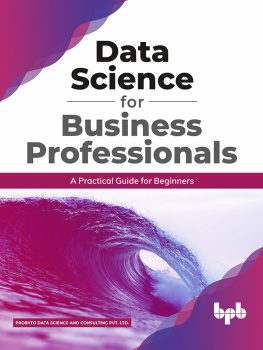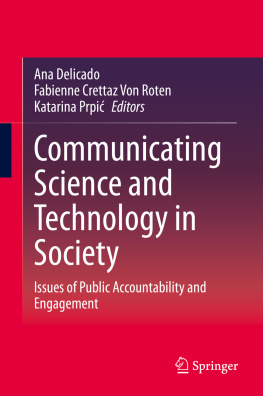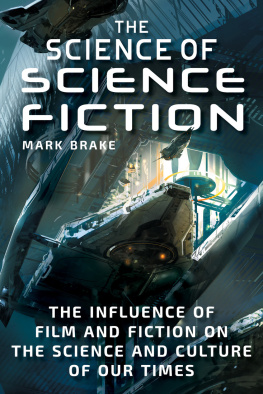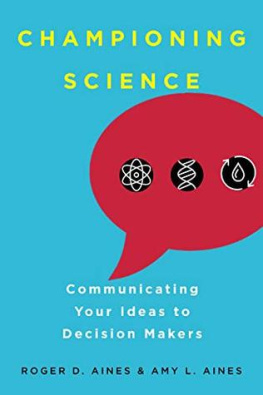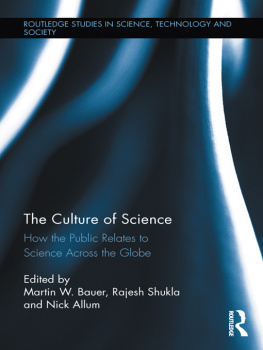Cormick - The Science of Communicating Science: the Ultimate Guide
Here you can read online Cormick - The Science of Communicating Science: the Ultimate Guide full text of the book (entire story) in english for free. Download pdf and epub, get meaning, cover and reviews about this ebook. City: Collingwood, year: 2020;2016, publisher: CSIRO Publishing, genre: Romance novel. Description of the work, (preface) as well as reviews are available. Best literature library LitArk.com created for fans of good reading and offers a wide selection of genres:
Romance novel
Science fiction
Adventure
Detective
Science
History
Home and family
Prose
Art
Politics
Computer
Non-fiction
Religion
Business
Children
Humor
Choose a favorite category and find really read worthwhile books. Enjoy immersion in the world of imagination, feel the emotions of the characters or learn something new for yourself, make an fascinating discovery.

- Book:The Science of Communicating Science: the Ultimate Guide
- Author:
- Publisher:CSIRO Publishing
- Genre:
- Year:2020;2016
- City:Collingwood
- Rating:5 / 5
- Favourites:Add to favourites
- Your mark:
- 100
- 1
- 2
- 3
- 4
- 5
The Science of Communicating Science: the Ultimate Guide: summary, description and annotation
We offer to read an annotation, description, summary or preface (depends on what the author of the book "The Science of Communicating Science: the Ultimate Guide" wrote himself). If you haven't found the necessary information about the book — write in the comments, we will try to find it.
Cormick: author's other books
Who wrote The Science of Communicating Science: the Ultimate Guide? Find out the surname, the name of the author of the book and a list of all author's works by series.
The Science of Communicating Science: the Ultimate Guide — read online for free the complete book (whole text) full work
Below is the text of the book, divided by pages. System saving the place of the last page read, allows you to conveniently read the book "The Science of Communicating Science: the Ultimate Guide" online for free, without having to search again every time where you left off. Put a bookmark, and you can go to the page where you finished reading at any time.
Font size:
Interval:
Bookmark:
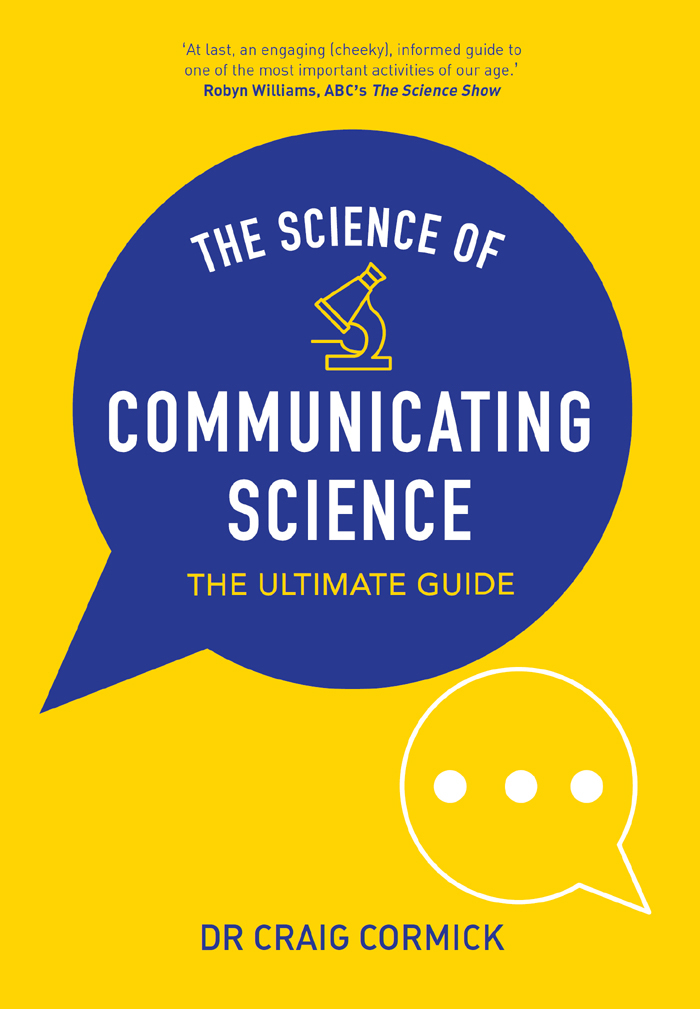
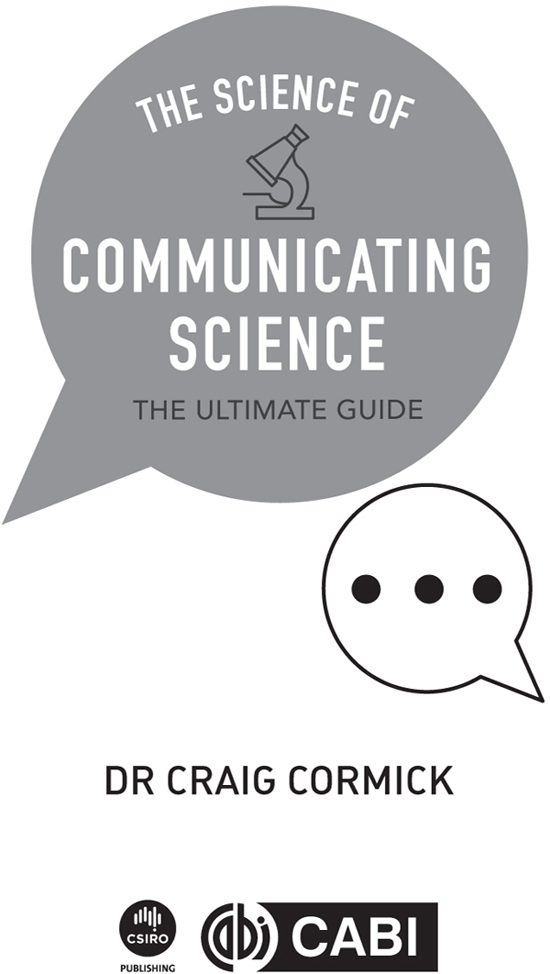
Craig Cormick 2019
All rights reserved. Except as permitted by applicable copyright laws, no part of this publication may be reproduced, stored in a retrieval system or transmitted in any form or by any means, electronic, mechanical, photocopying, recording, duplicating or otherwise, without the prior permission of the copyright owner. Contact CSIRO Publishing for all permission requests.
The author asserts their moral rights, including the right to be identified as the author.
A catalogue record for this book is available from the National Library of Australia and from the British Library, London, UK.
ISBN: 9781486309818 (pbk)
ISBN: 9781486309825 (epdf)
ISBN: 9781486309832 (epub)
Published exclusively in all formats throughout the world (excluding in Europe, Middle East, Africa and Asia) by:
CSIRO Publishing
Locked Bag 10
Clayton South VIC 3169
Australia
Telephone: +61 3 9545 8400
Email:
Website: www.publish.csiro.au
Published exclusively in print only (Europe, Middle East, Africa and Asia) by CABI.
ISBN 9781789245141
CABI | CABI |
Nosworthy Way | 745 Atlantic Avenue |
Wallingford | 8th Floor |
Oxfordshire OX10 8DE | Boston, MA 02111 |
UK | USA |
Tel: +44 (0)1491 832111 | Tel: +1 (617)682-9015 |
Fax: +44 (0)1491 833508 | E-mail: |
Email: | |
Website: www.cabi.org |
Set in 11/13 Adobe Garamond Pro and Myriad Pro
Edited by Karen Pearce
Cover design by Astred Hicks, Design Cherry
Typeset by Desktop Concepts Pty Ltd, Melbourne
Printed in Singapore by Markono Print Media Pte Ltd
CSIRO Publishing publishes and distributes scientific, technical and health science books, magazines and journals from Australia to a worldwide audience and conducts these activities autonomously from the research activities of the Commonwealth Scientific and Industrial Research Organisation (CSIRO). The views expressed in this publication are those of the author(s) and do not necessarily represent those of, and should not be attributed to, the publisher or CSIRO. The copyright owner shall not be liable for technical or other errors or omissions contained herein. The reader/user accepts all risks and responsibility for losses, damages, costs and other consequences resulting directly or indirectly from using this information.
The paper this book is printed on is in accordance with the standards of the Forest Stewardship Council. The FSC promotes environmentally responsible, socially beneficial and economically viable management of the worlds forests.
A very special thanks to all those who cast their eagle-eyes over the draft manuscript and provided insightful comments including Andrew Maynard, Brian Zikmund-Fisher, Elyse Aurbach, Susannah Eliott and Anna-Maria Arabia. A very special thank you to Katie Prater who went above and beyond in helping make this the book it now is.
In reading the many hundred journal articles and media reports and surveys and blogs that informed the content of this book, one quote stood out that I kept aside for the introduction, as I think it best captured what I was trying to achieve.
Professor Brigitte Nerlich of Nottingham University in the UK wrote in a blog post entitled Science communication: What was it, what is it, and what should it be?:
a whole academic industry has begun to flourish that is supposed to tell scientists what to communicate, how to communicate and for what reasons to communicate. Research into these matters has proliferated (and I have contributed to this proliferation). Unfortunately, the results of that research are largely published in places and in languages that scientists dont visit and dont really understand. As a result, there is some estrangement between those who still communicate and those who want to tell them how to do it.
In short, thats a problem that we need to do something about. What is the point of having all this great research into how to better communicate science if it is largely inaccessible?
Increasingly scientists recognise the call made by former head of the US National Oceanographic and Atmospheric Administration (NOAA), Jane Lubchenco, to acknowledge there is a social contract to communicate science with society but how to do that?
We have all these busy people doing the best they can in their fields, but who are far too time poor to hunt around all over the place and find those pearls of wisdom and research summaries that might help them better communicate science.
Somebody ought to do something about it, yeah?
Dr Craig Cormick
Somewhere something incredible is waiting to be known.
Carl Sagan, astronomer and science communicator
When I am asked what makes good science communication, I say, Just three things really know your audience, and tell a good story. Its so short and succinct you can tweet it.
And people then say, But thats only two things. Have you forgotten one?
And I say, Yes. Most people forget the third thing. That is being clear on what you want to achieve.
Is it that simple? Really? So I just need to memorise that and I can put this book back on the shelf and go and watch Netflix?
And then I have to say, No, of course its not that simple! What were you thinking? If it were that simple you would be able to learn everything you need to know from tweets and not from books! You need to know about messaging and trust and different values and so many things.
But it is a good starting point to memorise those three points and then probe into them a bit deeper. And yes, thats what were going to do.
But first a story.
I remember giving a conference talk several years ago to a crowded audience, right after lunch and I was working my way through my data slides on why different people had different attitudes to technologies and it started raining. Really, really hard. You could hear it bouncing off the roof above us.
There is something about the sound of rain, and a full stomach, that just lulls people to sleep (okay, my PowerPoint slides might have been a bit data-rich for this audience of agronomists too). I could see eyelids starting to close and people looking at their phones. So I stopped talking. Then I leant forward not looking at my notes anymore, and I said, Let me tell you all a story.
At once I had the eyes of everyone in the auditorium. The expectation of what I had to say was suddenly more interesting than their emails or Facebook or even a quick snooze. I dont know if I fulfilled their expectations with my story but the lesson was never lost on me. There is a certain mesmerising power in breaking into a story.
And think of all the different ways we can engage people through stories of some kind be it a blog post, a live experiment, a demonstration, a TV show or podcast. Most people get that at least in theory.
The second point, knowing your audience can be a little bit harder.
One of the Ancient Greek Oracles of Delphi (a sort of ancient Google who could speak wisdom after breathing intoxicating vapours that rose from chasms in the earth), stated, Know yourself . Even though she then tripped off on a vapour high and never finished the sentence, it became the Oracles motto and was inscribed into the forecourt of the Temple of Apollo at Delphi. It has since been interpreted in many ways, including
Font size:
Interval:
Bookmark:
Similar books «The Science of Communicating Science: the Ultimate Guide»
Look at similar books to The Science of Communicating Science: the Ultimate Guide. We have selected literature similar in name and meaning in the hope of providing readers with more options to find new, interesting, not yet read works.
Discussion, reviews of the book The Science of Communicating Science: the Ultimate Guide and just readers' own opinions. Leave your comments, write what you think about the work, its meaning or the main characters. Specify what exactly you liked and what you didn't like, and why you think so.

